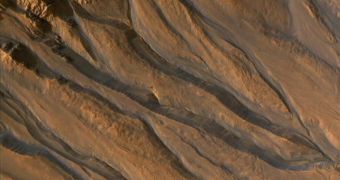We now know for a fact that liquid water once existed on Mars and that it's now gone in almost all regions of the planet. Ice still exists in the polar areas, where massive sheets, up to 95 percent pure, can still be found under a thin layer of dust and rock sediments. But the Martian atmosphere is altogether too cold to support liquid water, even though the high amount of salts that exist in the upper layers of the ground could allow for that to happen. Just recently, astronomers have discovered the newest traces of the liquid, as in the gullies that held the last streams of water ever to flow on the celestial body.
The newest scientific study on the surface of the Red Planet proves that the gullies that carried the last drops of liquid water were no more than 1.25 million years old, which means that, geologically speaking, water has stopped flowing on Mars just very recently. The strive is now to determine the overall conditions on the planet all those years ago and to establish whether the atmosphere that was present at the time, along with Mars' rotational tilt, could have made for a planet on which at least some forms of life could have survived.
There are a few reasons why astronomers believe that Mars wasn't always barren. First of all, over the past 10 years of the survey, numerous geological features have been discovered that hint at streams and lake beds and which have the same appearance as similar formations on Earth. In addition, the bottoms of some craters look as though they were covered with water for a variable amount of time. Nevertheless, the most important thing is that rovers have discovered water-bearing minerals in these formations, including opals and carbonates, which only form when water interacts with the Martian dust.
“You never end up with a pond that you can put goldfish in. You had ice that typically sublimates. But in these instances, it melted, transported, and deposited sediment in the fan. It didn't last long, but it happened,” Brown University graduate student Samuel Schon, who is a member of the study team, shares. “We think there was recent water on Mars. This is a big step in the direction to proving that,” Brown scientist Jim Head, who is also part of the team, adds.
Also, the experts write in the latest issue of the journal Geology, the ice and liquid water formed at a time when the planet's axis was tilted differently than it is today, which would explain why the traces of water flows appeared at mid latitudes and not at the poles. Over time, as the planet corrected its axis, the ices migrated to the North and the South poles, respectively, where they became covered with sediments.

 14 DAY TRIAL //
14 DAY TRIAL //